Question: What do a Georgian country estate, an African American Methodist Church, the Whiskey Rebellion, and Chester County all have in common?
Stumped? Can’t think of an answer? Then you’re not paying attention! It’s the last Wednesday of the month, which means its SHPO Shout-Out Day, and this month’s Shout Outs go to an interesting array of worthy preservation activities in Pennsylvania. That’s not to say that these are the only good preservation projects out there. We know there are more! You just need to drop me a note and tell me about what’s going on in your neck of the woods.
 The Woodlands
The Woodlands
We’ll start off with this Georgian estate in Philadelphia. These folks have been hard at work preserving and restoring William Hamilton’s 18th century country home, The Woodlands. After an inspirational trip to England, Hamilton began a massive inside-and-out renovation in 1786 of his neoclassical home into the more fashionable Georgian style. Many cite The Woodlands as the nation’s first example of Federal architecture. One of the really cool things Hamilton did was to add a cryptoporticus (this is your SAT word of the day!). I had to go dig out my old-school architectural dictionaries for this one – it’s an underground, covered passageway that is wholly or partially concealed and lit along one-side. This vaulted brick space became part of the subterranean passageways that guiding servants throughout the building’s foundation to different domestic work spaces, cellar, stable, kitchen garden and other service areas. The Woodlands cryptoporticus is largely concealed with only the open tops of an arcade visible at ground level.
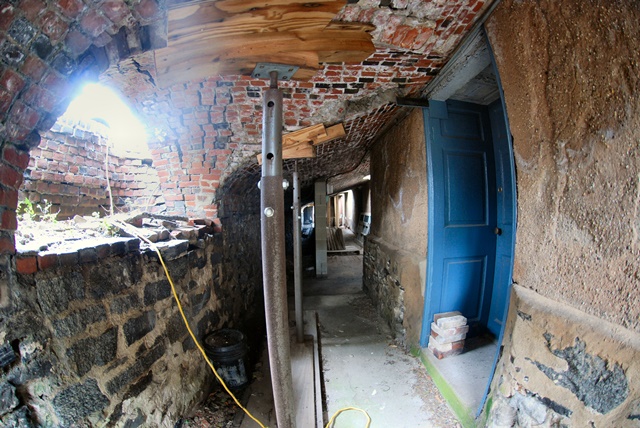
The cryptoporticus before restoration, with metal and concrete block supports.
Time and gravity took its toll on this underground walkway, and the temporary interventions made it difficult and eventually unsafe to share the space with visitors. In 2012, The Woodlands started a lengthy restoration process of the cryptoporticus with the goal of re-opening the space and begin interpreting the domestic functions of the house and how they connect to the greater landscape of the site. The restoration included a detailed conditions assessment, structural and materials analyses and recommendations, extensive documentation, archaeological monitoring, and construction. Some lucky workers got to number all of the 10,000 bricks that were removed and re-installed! The reconstructed passageway includes hidden stainless steel rods and a carefully designed concrete topping slab to address the engineering issues that led the space’s deterioration in the 20th century. With the structure sound, the new terrace and original marble steps and coping stones were conserved and reinstalled. The next phase of work, happening now, includes wood conservation, window restoration, roof work, painting, repointing, and exterior lighting.
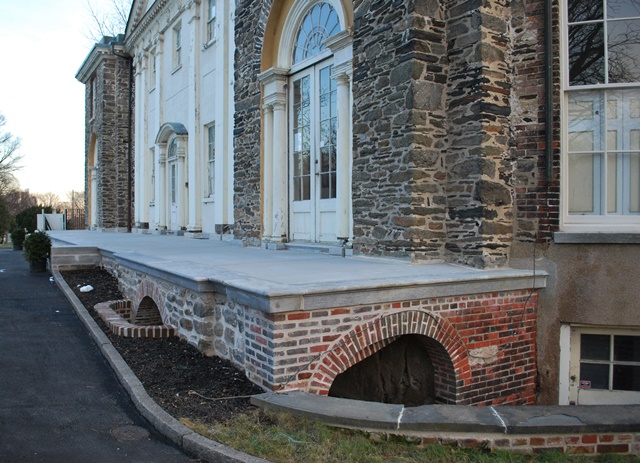
The restored cryptoporticus is now ready for visitors. Visit The Woodlands to see it for yourself!
Chester County
On March 1 our staff had the pleasure of spending a day in Chester County, and visited a wide range of great projects. Kudos to Upper Oxford Township, for their efforts to preserve and celebrate their agricultural character and rural sense of place; to the County’s Parks Department, for their interpretation and preservation plans for a canal branch near Phoenixville; to the Callahans, for their stewardship of and enthusiasm for the lovely Mendenhall-Valentine-Edge House; to the volunteers working to stabilize and reuse the Bondsville Mill as part of a new East Brandywine Township Park; and to West Nantmeal Township, for their promotion of local iron industry heritage and the sisters managing Langoma at Isabella Furnace for keeping the buildings in active and well-maintained use. And thanks to the County’s Planning Department for organizing such an inspiring and rewarding tour!
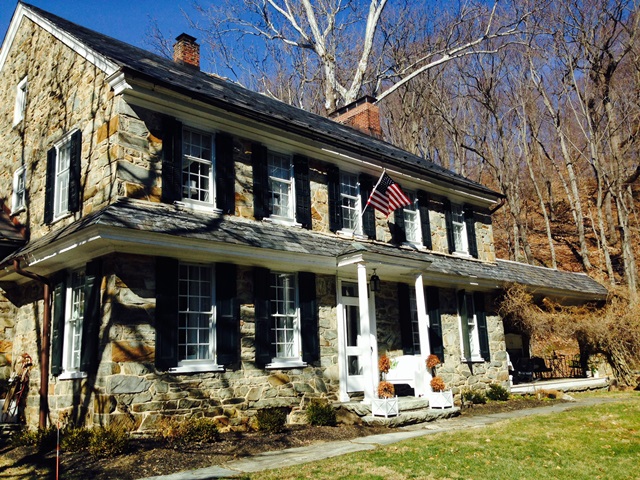
The Callahans are doing a wonderful job maintaining the Edge House and restoring outbuildings; the Edge family certainly found the perfect new stewards for this property! A different owner is doing an equally admirable job rehabbing the former Edge mill across the street.
Woodville Plantation
We are excited to share the news that the Neville House Associates (NHA) have wrapped up some preservation work at the Woodville Plantation, Allegheny County, thanks to a Keystone Historic Preservation Construction grant. Woodville is the home of John and Presley Neville, first built in the late 19th century and expanded and redesigned into its current state in the mid to late 19th century. John Neville was a prominent citizen and became the local tax collector responsible for collecting the unpopular tax on whiskey, which led to the Whiskey Rebellion in Pennsylvania. Much of Neville’s house and property were burned in protest of the tax.
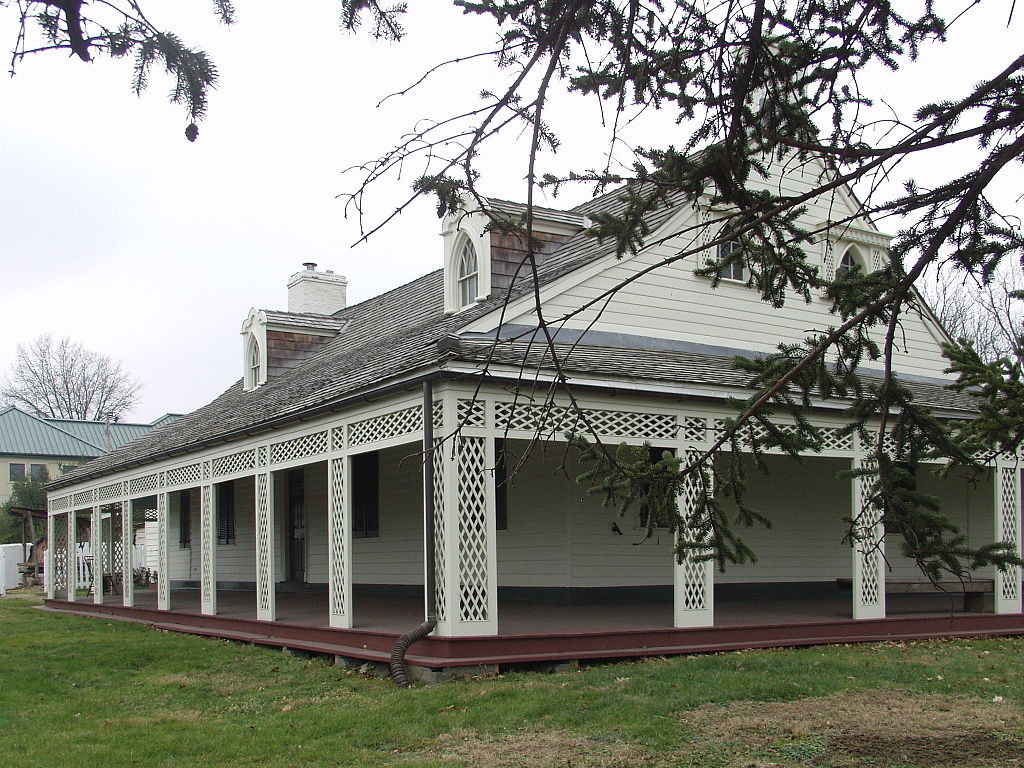
As stewards of the National Historic Landmark Woodville Plantation, NHA was able to secure a Keystone grant to repair and restore selected sash and glazing, and replace the copper gutters and downspouts to redirect drainage system away from the house to prevent future water damage to the house. Not only did this grant allow them to make key repairs, but it was also a big boost that enabled them to increase their capacity and solidify relationships with other funders. Through the generosity of a grant from the Allegheny Foundation, NHA has also been able to hire a part time administrator to keep this treasure going.
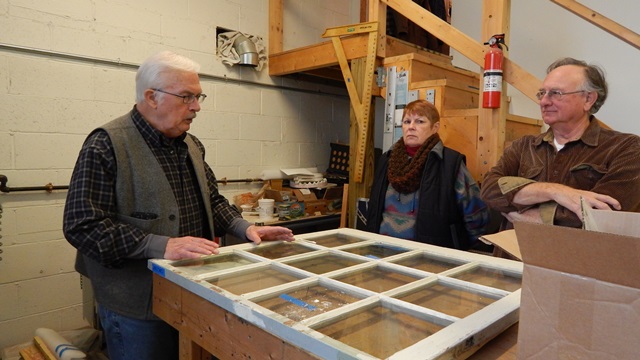
Volunteers with NHA working with restored wood windows.
Ebenezer Methodist Church
On February 29, eastern region Community Coordinator Cory Kegerise attended Ebenezer Methodist Church’s 175th anniversary celebration in Norristown, Montgomery County. The congregation dates to 1840 and the church was constructed in 1872. Before and during the Civil War, church members, along with local Quakers, were active in the abolition movement and helping runaway slaves escape from Maryland and Delaware.
The anniversary event and local marker dedication took place after their morning service, and in addition to the congregation, included members of other black churches in Norristown, local and state elected officials, and the press. In addition to presentations of citations from Congress, the Pennsylvania House of Representatives, and Norristown Municipal Council, Cory spoke to the congregation about the importance of their recognition of their history and the Executive Director of the Historical Society of Montgomery County made a few remarks. The church also presented plaques to the other churches in the community commemorating various historical ties and shared events in their pasts. Concluding the celebration was the dedication of their own self-funded historical marker (not to be confused with the official Pennsylvania Historical Markers).

Dedication of the local marker
As always, my last SHPO Shout-Out is to thank you for all the good work you do every day to preserve, protect, and promote our historic places!
P.S.
If you or your friends and colleagues are involved in or hear about great preservation happening in Pennsylvania,
please email me at ssplain@pa.gov with your suggestions! While I can’t promise that it will get covered in the monthly Shout-Out, I can promise that we’ll add it to our growing list of great preservation work happening across Pennsylvania. Quick reminder: eligible Shout-Outs must be related to SHPO program areas (the National Register, historic resource survey, historic tax credits, Keystone grants, community coordinators/preservation planning, CRGIS, historic markers, and environmental project review/mitigation) and can recognize small baby steps to large milestones, and everything in between, led by the public, an organization, municipality, community group, regional government, or state or Federal agency. Thanks!
Comment Policy
PHMC welcomes and encourages topic-related comments on this blog. PHMC reserves the right to remove comments that in PHMC’s discretion do not follow participation guidelines.
Commenters and Comments shall be related to the blog post topic and respectful of others who use this site.
Commenters and Comments shall not: use language that is offensive, inflammatory or provocative (this includes, but is not limited to, using profanity, obscene, or vulgar comments); disparage other commenters or people; condone illegal activity; identify the location of known or suspected archeological sites; post personal information in comments such as addresses, phone numbers, e-mail addresses or other contact details, which may relate to you or other individuals; impersonate or falsely claim to represent a person or an organization; make any commercial endorsement or promotion of any product, service or publication.
If you would like to comment on other topics not related to this blog post but related to PHMC, please fill out the PHMC Contact Us Form.

Leave a Reply